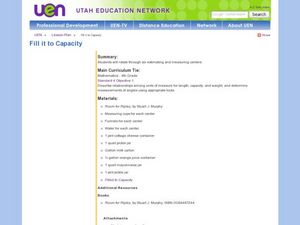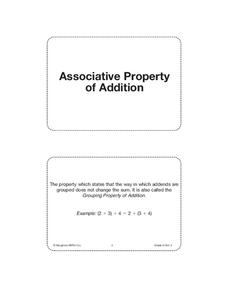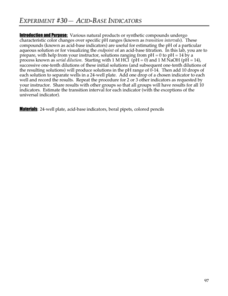Illustrative Mathematics
How Thick Is a Soda Can I?
The humble soda can gets the geometric treatment in an activity that links math and science calculations. After a few basic assumptions are made and discussed, surface area calculations combine with density information to develop an...
EngageNY
Sampling Variability in the Sample Mean (part 1)
How accurate is data collected from a sample? Learners answer this question using a simulation to model data collected from a sample population. They analyze the data to understand the variability in the results.
EngageNY
Sampling Variability in the Sample Proportion (part 1)
Increase your sample and increase your accuracy! Scholars complete an activity that compares sample size to variability in results. Learners realize that the greater the sample size, the smaller the range in the distribution of sample...
Curated OER
Estimate Sums: Practice
In this estimating sums instructional activity, learners round each addend to the nearest ten and then estimate the sums. Students finish with one test prep question by estimating for the sum.
Curated OER
Estimate Sums: Homework
In this estimating sums worksheet, students round each addend to the nearest ten using the number lines. Students then estimate the sum for each addition problem.
Curated OER
Rounding and Estimation
In this rounding and estimating worksheet, students learn how to round numbers up and down. They also read about using estimations to quickly calculate answers to difficult math problems. Students then solve the 12 rounding questions in...
Curated OER
Rounding and Estimation
Fifth graders participate in a lesson that is focused on rounding and estimating using word problems. They review how to read word problems, find the right operator, and use the new skills to solve problems.
Curated OER
Estimate Sums
In this estimating sums worksheet, students round numbers to the greatest place and then add them to solve 23 problems. Students also solve 2 test prep questions.
Curated OER
Rounding Numbers
In this online interactive rounding numbers worksheet, students use their math skills to fill in the 21 blanks that require them to round to the tens, hundreds, and thousands.
Curated OER
Units Of Measure
Students investigate concepts relating the use of the metric system of measurement. They practice the skill of estimating units and especially which ones to use in certain problems for the most reasonable answer. The lesson includes...
Curated OER
Telling Time as an Everyday Use of Numbers
How can we estimate time? Have your young mathematicians make a clock. Then they compare and contrast types of clocks. They practice writing times in two different ways and make a book about telling time.
Illustrative Mathematics
Estimating Square Roots
No calculators! Assure your learners that they can find the square root of a large number. All they need are two known squares close by and a table. Come up with an additional practice and your number crunchers will have it mastered in...
Math Mammoth
Customary and Metric Measurement
Through a series of worksheets, mathematicians practice with various concepts of measurement. Conveniently, the 6 pages are easily broken up for individual assignments, and seem to progress in difficulty. Math concepts include drawing...
Concord Consortium
Fermi Volume
It is about this big. An assessment provides three questions on the estimations of volume. Pupils determine the quantities needed and use dimensional analysis to arrive at estimations involving dollar bills, paint, and gasoline.
Concord Consortium
Fermi Time
It's all just a matter of time. The resource provides four Fermi questions in reference to time. The questions are open-ended and require classmates to make use of estimation and dimensional analysis.
Curated OER
Mark, Recapture, Sampling
Learners conduct a simulation to explore how scientists estimate the size of animal populations. They analyze a random sample and then extrapolate those results to a larger population. Additionally, they will apply the principals of...
Balanced Assessment
Fermi Length
How long does it take to get to the end of a toilet paper roll? Pupils use their estimation strategies to find lengths of common items. For example, knowing the area of a roll of toilet paper, scholars determine the length of the full roll.
David Pleacher
Candy Math Fun
Few things can motivate children to learn like the promise of a sweet and tasty treat. Given a bag of M&M®s, Skittles®, or other colorful candy, students first predict the contents of the bag before counting the pieces, creating a...
Balanced Assessment
Fermi Area
Discover creative ways to use surface area formulas. In the assessment task, scholars apply estimation strategies to determine surface area in non-routine problems. They consider surface area of kitchen sponges, rock salt crystals, and...
CK-12 Foundation
Area Sums: Estimation with Rectangles
The more rectangles, the better the estimate. Using the interactive, pupils explore estimating the area under a curve using left-hand sums. Learners respond to challenge questions on how to get better estimates using the same technique.
Teach Engineering
Cost Comparisons
Our final proposal for the cost of the bridge requested is ... In the last segment in a series of 10, pairs work together to develop a proposal for a city bridge design. The class completes a cost comparison between concrete and steel to...
Houghton Mifflin Harcourt
Unit 2 Math Vocabulary Cards (Grade 3)
A set of third grade math vocabulary cards include topics that range from addition properties to terms like estimate and fact family. Each sheet has two cards on it. The top half is the word printed in bold text, while the bottom is the...
CK-12 Foundation
Length of a Plane Curve
Challenge your class to use straight lines when estimating the length of a curve. An engaging interactive allows individuals to place line segments one after another along the arc. Learners determine that the more lines used, the better...
Pingry School
Acid-Base Indicators
Acid-base indicators are an essential part of any chemistry classroom. Individuals explore the color-changing feature of the important indicators in a vibrant hands-on activity. Using serial dilution, learners create solutions ranging...

























